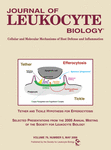-
Views
-
Cite
Cite
Barbara Bottazzi, Antonio Bastone, Andrea Doni, Cecilia Garlanda, Sonia Valentino, Livija Deban, Virginia Maina, Alessia Cotena, Federica Moalli, Luca Vago, Antonietta Salustri, Luigina Romani, Alberto Mantovani, The long pentraxin PTX3 as a link among innate immunity, inflammation, and female fertility, Journal of Leukocyte Biology, Volume 79, Issue 5, May 2006, Pages 909–912, https://doi.org/10.1189/jlb.1005557
Close - Share Icon Share
Abstract
The long pentraxin 3 (PTX3) is member of a complex superfamily of multifunctional proteins characterized by a cyclic multimeric structure. PTX3 is highly conserved in evolution and is produced by innate-immunity cells in response to proinflammatory signals and Toll-like receptor engagement. PTX3 plays complex, nonredundant functions in vivo, acting as a predecessor of antibodies, recognizing microbes, activating complement, facilitating pathogen recognition by phagocytes, and hence, playing a nonredundant role in resistance against selected pathogens. In addition, PTX3 is essential in female fertility by acting as a nodal point for the assembly of the cumulus oophorus hyaluronan-rich extracellular matrix. Thus, the prototypic long pentraxin PTX3 is a multifunctional, soluble pattern recognition receptor acting as a nonredundant component of the humoral arm of innate immunity and involved in matrix deposition and female fertility.





